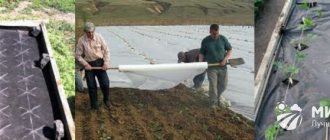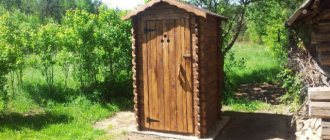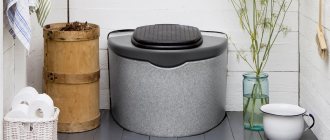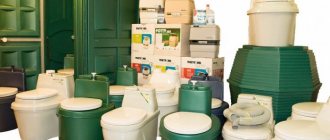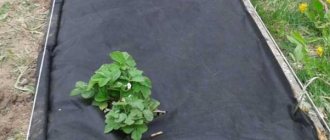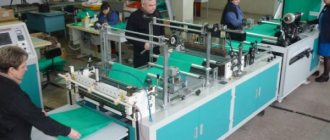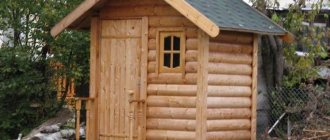Author: Elena N. https://floristics.info/ru/index.php?option=com_contact&view=contact&id=19 Category: Garden plants Published: January 10, 2019Last edits: January 06, 2021
In order to protect garden and horticultural crops from the negative influence of weather and climatic conditions, birds, pests and pathogens, which impede normal growth and development, gardeners use special covering material of artificial origin. We will tell you about what types of covering material exist, and also describe the properties, purpose and methods of using each of them.
Types of covering material
Based on their composition, covering materials are divided into two categories: polyethylene and non-woven (agrofabric, agrofibre), which are available in white and black. A two-color material has also appeared on sale, consisting of a black bottom layer and a white top layer: the black side of the canvas is laid on the soil so that weeds do not develop in it, and the top white side will reflect light. As a result, the soil does not overheat, and the plants receive more light, develop faster and ripen earlier.
Using covering material, you can:
- achieve a significant increase in crop yields;
- protect plants from the negative effects of low temperatures;
- achieve faster fruit ripening;
- retain moisture in the soil during dry times;
- spend less effort cultivating the soil.
Shading grid
Shading mesh can also be considered a covering material. It is made from polypropylene with the addition of an ultraviolet stabilizer. Often in stores there is a green color option, but there is also a neutral white color. Nets of the required size are made to order, the standard width is 4 m. The material is used to protect agricultural plants from the scorching sun: they cover greenhouses, grapes, and young fruit trees. Used to collect fruits, spread under trees
When choosing a material, the main criterion is your expectations and the effect of application. If you need protection from return frosts, then white spunbond or film is suitable. Black materials are suitable for mulching. Of course, everything depends on the financial side of the issue. But if you are engaged in growing crops on an ongoing basis, then it is worth investing once rather than spending money and time every year on purchasing and installing a shelter.
Polyethylene materials
Polyethylene film is a covering material that has long been known and is still in demand in gardening and vegetable growing. It is sold in the form of sleeves or rolls. The thickness of the polyethylene film is from 0.03 to 0.4 mm. This material transmits light very well, protects plants from low temperatures, rain, wind, and retains heat.
- How to preserve grape cuttings in winter: we inspect and determine whether all cuttings are healthy?
However, the film has the following disadvantages:
- it has low water and breathability;
- constructing a greenhouse requires the use of metal arcs, without which the film will not hold the shape of the dome;
- Condensation accumulates on the surface of the film, impeding air exchange and promoting the development of diseases in plants;
- After rains, the film from accumulated water sags and falls.
In the photo: Application of polyethylene
In addition, polyethylene is short-lived: its service life is usually one season. True, you can use a special type of polyethylene covering for the construction of greenhouses and greenhouses - reinforced film, which, although not so plastic, will last longer. Types of film have also appeared on sale that have the property of activating plant photosynthesis, as a result of which crop resistance to adverse factors increases, they grow better and develop faster.
In the photo: Polyethylene covering material
Application when mulching the soil
Black lutrasil is often used for mulching plantings, paths and row spacing. The bed, which is prepared for planting the plant in the spring, needs to be covered with black lutrasil and cuts made. The following crops are planted in them:
- tomatoes;
- cucumbers;
- strawberries;
- onions and much more.
Plants are also watered through these cuts. Lutrasil does not collect condensation, prevents the formation of excessive dampness, does not contribute to the appearance of mold, and the soil ultimately remains loose. You can also find on sale two-color material for mulching the soil, the upper part of which has a white tint, so that the root system will not heat up too much . Lutrasil strips are also placed under the main coating when laying decorative paths on the site. On average, the service life of such covering material for mulching is about three years.
Non-woven covering materials
Advantages and disadvantages of non-woven agrofibers
Today there are many non-woven covering materials on the market under different names, but the most famous of them are the brands “Agrotex”, “Agrospan”, “Spunbond”, “Lutrasil” and “Agril”. What are the advantages of non-woven materials over polyethylene covering?
Here are the main advantages of non-woven fabrics:
- they can be used to construct greenhouses without a metal frame;
- non-woven materials have qualities such as softness and lightness, and do not injure plants upon contact;
- these fibers perfectly allow air, light and water to pass through: plants can be watered without removing the agro-fabric;
- they are resistant to ultraviolet rays, accumulate heat and protect plants from harmful radiation;
- they can be used in greenhouses and greenhouses as a second covering layer;
- nonwoven materials are absolutely harmless to humans and the environment;
- They are easy to use, tear resistant, and can be washed, stitched or glued.
In the photo: Non-woven covering material
Nonwoven materials differ in density as follows:
- lightweight (14-17 g/m²), which are available only in white: they will protect your plants from spring frosts, the burning sun, insects and birds;
- medium (28-42 g/m²), also exclusively white. Such materials are intended for constructing greenhouses, greenhouses and protecting shrubs and crops from winter frosts;
- dense (60 g/m²), which can be either white or black and are used for the same purposes as medium-density materials. Black agrofabric is often used to mulch the soil: without receiving light, weeds cannot develop and die, and the crop protected by the agrofibre is planted in its slots.
However, even these wonderful materials cannot save gardeners and gardeners from all the work: in order for insects to pollinate cucumbers, strawberries or zucchini, agrofibre must be removed in the morning and pulled back onto the bed in the evening. In addition, the coating can be damaged by crows, cats or dogs.
Lutrasil
This material looks like a light spider web. Condensation does not form on its surface, so it can be kept on the beds for a very long time.
Lutrasil is available in different densities:
- thermoselect – white lutrasil with a density of 17 g/m², used to protect plants from frost down to -2 ºC;
- frostselect – white material with a density of 30 g/m², capable of protecting beds from frost down to -6 ºC;
- lutrasil with a density of 42 and 60 g/m², used for constructing greenhouses;
- Lutrasil 60 UV is a lightweight, elastic black fabric used for mulching the soil and suppressing the growth of weeds.
Spunbond
Spunbond is a white or black non-adhesive non-woven fabric that creates a special microclimate for plants: it retains heat, allows sunlight, air and water to pass through, but does not rot. Black spunbond is intended for mulching beds and controlling weeds, and the purpose of the white material depends on its density:
- Fertilizers for a rich harvest - what, why and in what proportions to use?
- spunbond SUF 17 is designed for frameless shelter of plants from pests, heat and dry air;
- SUF 30 is used to protect crops from temperature changes and at night. It is usually stretched over a frame;
- SUF 42 material protects greenhouse plantings from frosts down to -3 ºC;
- SUF 60 saves plants in greenhouses and greenhouses from frosts down to -6 ºC and below. Tree trunks and shrubs are wrapped with this material for the winter: it will not only warm them, but also protect them from rodents.
In the photo: Spunbond
Agril
This easy-to-use, durable non-woven material has excellent permeability to moisture, air and sunlight, while dispersing it well. It does an excellent job of protecting plants from both heat and low temperatures. When mulched, agril protects the soil surface from compaction, protects it from erosion and promotes crop ripening at least a week ahead of schedule. On sale there is transparent agril with a density of 17 and 40 g/m² for constructing greenhouses and protecting plants from heat and cold, as well as black agril with a density of 50 g/m² for mulching vegetable and strawberry beds.
Under the mulching non-woven fabric, biological processes are not disturbed, so the soil does not need to be weeded or loosened.
Agrotex
This environmentally friendly non-woven material, safe for the environment and humans, provides excellent protection for plants from cold dew and frost down to -2 ºC, and can withstand heavy rains, hail and scorching sun rays. Agrotex allows moisture, air, and 90% of sunlight to pass through, accelerating fruit ripening by two weeks without the use of chemicals.
Agrospan
Agrospan can be used both in winter and summer. This fabric combines all the best qualities of non-woven materials: in cold weather it protects seedlings, seedlings and germinating seeds from cold snaps, and in summer it saves plants from sunburn without absorbing light. The texture of agrospan, like spunbond, resembles non-woven fabric. It is also available in white and black. Black agrospan is used for mulching beds, and white agrospan is used for organizing shelter for greenhouses and hotbeds. UV stabilizers extend the life of the material, which can be used for three seasons.
We offer you video material that will help you better understand the types of non-woven covering material:
Manufacturers and retail price
The leading brands of nonwoven material for agriculture are Lutrasil (Freudenberg, Germany), Agril (Avintiv, France), Agrotex (Geksa Group, Russia), Agrin (Unispan, Ukraine) and Plant-Protex (Poland). On the Russian market you can buy spunbond from any manufacturer from official representatives and regional managers or in gardening stores.
For farms, covering material is sold in rolls of 100 m or more, the most popular width is 160 or 320 cm. When ordering products to order, dimensions may vary. For the needs of summer residents, manufacturers produce canvas 10 m long.
On the Internet you can find specialized stores offering spunbond at manufacturer’s prices, with additional discounts for wholesale. However, for a private country house, even retail will be quite acceptable. The price per meter is determined by the density of the material and the type of spunbond.
For wholesalers, the average price of spunbond with a density of up to 42 g/m2 is 3-6 rubles/m2, a density of 60-80 g/m2 will cost 7-12 rubles/m2. The average retail price (for 2016) for a package of 10 m of canvas will range from 170 (width 320 cm, density 17 g/m2) to 550 rubles. (width 320 cm, density 60 g/m2).
Agril
Agril is a covering material with a high degree of light permeability, but it also scatters ultraviolet radiation well. That is why in the hot season the plants will not steam, and during frosts they will not become hypothermic. The fabric allows air and moisture to pass through well. In addition, it is durable and easy to use.
Agril helps protect the soil from erosion, crust formation on the soil, compaction, and will shorten the ripening period of plants. Black agrill does not allow light to pass through and eliminates the need for frequent weeding.
What types of paintings are there?
Today, a modern summer resident has a huge selection of products that protect plants from bad weather. Covering nonwoven materials are presented in a very wide range, and among the most popular types we should highlight:
- lutrasil;
- spunbond;
- agril;
- agrospan;
- Lumitex.
Each of these types of materials has its own specific characteristics that must be taken into account when choosing them.
Agrospan
Agrospan covering material is suitable for use at any time of the year. This canvas combines the best qualities of other products. During the cold season, it helps protect seeds, seedlings and seedlings from frost. In summer, it provides protection from excessive amounts of ultraviolet radiation.
Agrospan is a synthetic fiber that looks like non-woven fabric. Manufacturers produce canvases in black and white. White material is ideal for covering seedlings in a greenhouse or greenhouse. The black material is used for mulching the soil. It provides protection against weeds and pests.
With the help of new technologies used in the production process, a strong and durable fabric is obtained. It has the following advantages:
- creating the required microclimate;
- protection against overheating and excessive cooling of the soil;
- reducing watering;
- protection from pests and diseases;
- durability.
However, this fiber also has certain disadvantages. The main disadvantage is considered to be the low level of thermal insulation, which has a very bad effect on the growth of heat-loving plants.
What's better
It all depends on the goals. Since film retains heat better than agrofibre, it is better to use it at the beginning of the season, using it for greenhouses while it is still cold outside. When the soil has already warmed up well, the film can be replaced with agrofabric. With it, the plants will be ventilated, moisturized, and there is no need to remove it when feeding.
Find out how tomatoes are grown in a polycarbonate greenhouse from this article.
If plants requiring pollination are covered with non-woven material, it must be removed for the day.
Spunbond
In the last few years, spunbond non-woven covering material has begun to be in great demand.
As a result of a special manufacturing method, a wear-resistant, durable and strong material is obtained, which is widely used in various fields of agriculture. Depending on the density of the canvas, it can be used in open or protected ground. We can highlight the main areas where this product can be used. It is used for:
- accelerating soil warming;
- obtaining the earliest possible shoots;
- protecting the surface layer of soil from drying out;
- protecting plants from severe frosts.
Before using Sanbond to protect plants from bad weather conditions, you need to take into account its main technical characteristics:
- good breathability;
- light transmittance;
- low weight;
- homogeneous structure;
- resistance to adverse factors;
- is not subject to putrefactive changes and bacteria.
Spunbond can be used at any time of the year. In spring, it helps to better warm the soil for early sowing. In addition, high-density spunbond can be used to cover greenhouse and greenhouse frames.
Lumitex – protection against negative ultraviolet rays
This material is capable of transmitting blue and red rays of the ultraviolet spectrum. Moreover, Lumitex also converts green rays into blue, which enhances the flow of active radiation, reflecting and retaining that part of the radiation that is harmful to plants.
Lumitex differs not only in its properties from other materials, but also in its appearance: it is soft, ribbed, and pinkish in color. Most often used to protect strawberry and cucumber beds, which ensures harvesting 12-15 days earlier. In addition, the yield increases by 35-45%. Lumitex is often used with polyethylene film. To do this, the walls of greenhouses are covered with lumitex, and the roof is covered with film. A linear meter of Lumitex costs from 90 rubles.
There are many varieties of covering material, which differ not only in appearance, but also in density, properties and the material itself (film or fabric)
